Volleyball drills for technique serving
- Players divide on both back lines as two teams.
- All have a ball.
- Players one half take turns serving all.
- On wrong service, all run to the net and make block jump.
- Other team does the same.
- Done when both teams have a mistake-free service series.
Variations:
- serve with restrictions (one half or length (for 7m line))
- only overhand
- Attention:
- Good service also under pressure
- concentration
- Place a mat at random in each field.
- On 2 sides stand a group to serve.
- Serve on the mat.
- Then run after your ball, make a dive, make a block and join the line on the other side.
- Who hit the mat the most?
- Players should try to stand as close to the back line as possible, but if they can't they may move closer to the net
- 2 teams, each team has its own field
- facing each other with a net in between.
- The players serve each other from behind the back line.
- If a player serves a ball wrong (in the net, out, etc.) he must lie down on the side of the other team.
- A player may return if a teammate serves a ball to him.
- if a whole team lies on the ground, the other team has won.
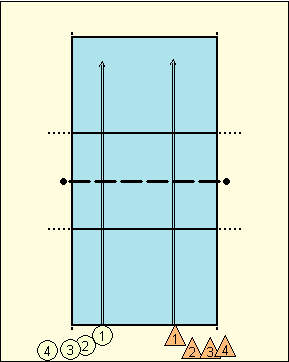
This exercise is fun to do and gives a lot of fun and competition! Relays in general already create competition.
What this exercise also wants to mimic is the stress factor that a serve brings.
The players are divided into equal teams and lined up on the serving area of the same court. The first player of a team serves and retrieves his ball. After the next player is tapped, this one serves, and so on.
It is important for a player to serve quickly, but it must also be flawless, otherwise the ball must be retrieved and served again!
Needs:
- A minimum of 6 players
- As many balls as there are teams
- Place a mat at random in each field.
- On 2 sides stand a group to serve.
- Serve on the mat.
- Then run after your ball and join the line on the other side.
- Who hit the mat the most?
- Players should try to stand as close to the back line as possible, but if they can't they can move closer to the net.
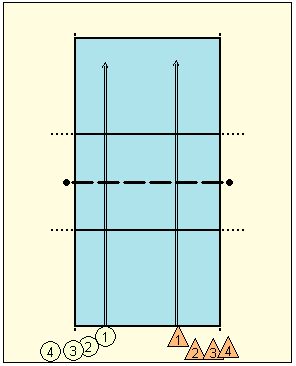
What this exercise also aims to mimic is the stress factor that a serve brings.
The players are divided into equal teams and lined up in rows on the serving area of the same court. The first player of a team serves and retrieves his ball. After the next player is tapped, this one serves, and so on.
It is important for a player to serve quickly, but it must also be flawless, otherwise the ball must be retrieved and served again!
5 rounds
In each field 1 passer, 1 catcher, 1 reserve and 2 server.
With 12 players place 2 passers and always let the inner passer go to midfield
.
Serve, reserve, pass, catch and serve. Chasing your ball.

Goal:
players throw the ball up in front of the body at the arm
- players stand next to the line and throw the ball up, so that it falls on the line
- left leg is in front
Then serve to each other in pairs. It is about throwing up the ball well.
- Players serve from position 1 to 5.
- When player A1 serves, player B5 stands in the field and catches the service.
- Player A1 becomes reserve and player B5 becomes reserve.
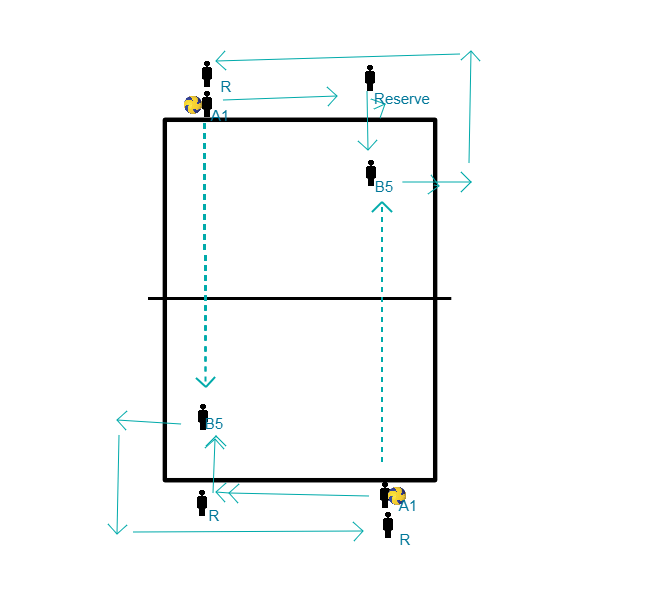
Objective:
Improving the pass by staying behind the ball
- Passer stands against the back line in starting position pass
- Player at the net throws the ball alternately short and deep.
- P moves forwards and backwards and passes to S
- S catches the pass
- Change after 10 balls
Then in threes:
- Passer stands in the starting position in the backfield and moves sideways opposite player 1 and 2
- Players 1 and 2 take turns passing the ball to P who returns it under arms
- Players 1 and 2 catch the pass
- after 10 times turning around
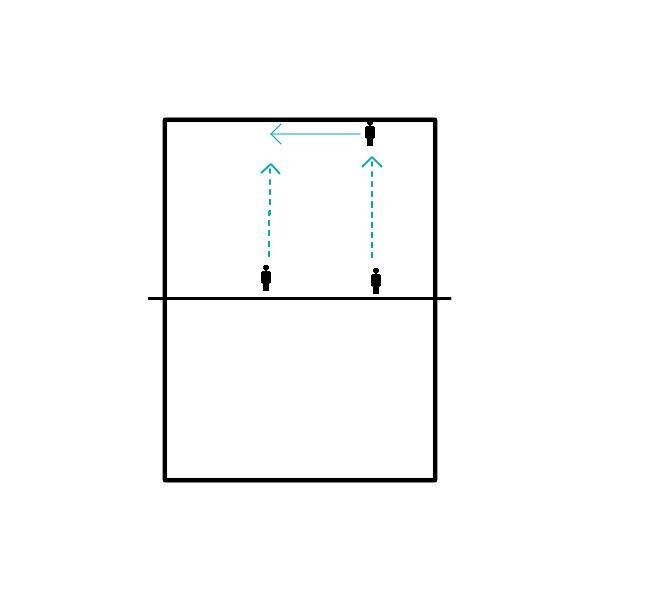
- If the service is wrong (out or in the net), the player must lie down in the field on the other side of the net
- The player may return if a team-mate serves exactly where he lies.
Apart from technique, communication is important in volleyball. And both aspects also apply to this exercise. And reacting adequately to situations that go differently than normal. In this kind of exercise you can see very well how different players are.
- We start with 5 minutes of serving for everyone.
- Then this exercise begins
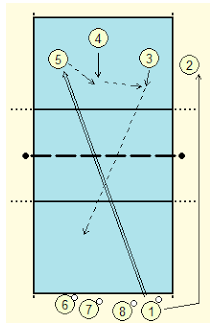
- Three players line up to pass (numbers 3, 4 and 5). Player 2 stands ready at the side of the same court. The other players are ready with the ball to serve on the other side.
- Player 1 serves the ball (and then immediately runs to where player 2 is already standing)
- A player passes the ball. Another player gives a setup. And the third player plays the ball over the net. All three players must play the ball, either a pass, or a setup, or an attack.
- Once the ball is over the net, the players turn: 2 goes into the court (where 3 was first) 3 goes to mid-back, 4 goes to the spot of 5 and 5 goes the serving spot of the other half.
- Then the next player can serve, on the drawing this is player 8. Etc.
- Place a mat at random in each field.
- On 2 sides stand a group to serve.
- Serve on the mat.
- Then run after your ball and join the line on the other side.
- Who hit the mat the most?
- Players should try to stand as close to the back line as possible, but if they can't they can move closer to the net.








